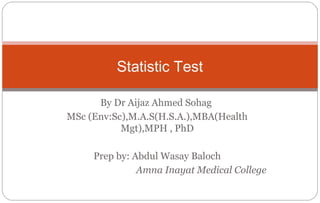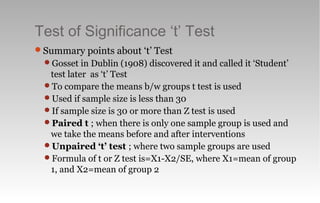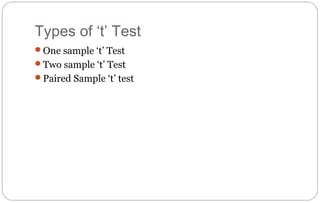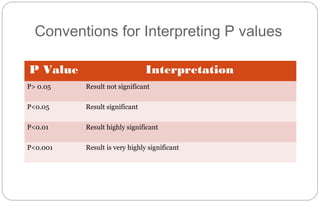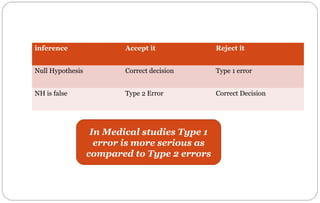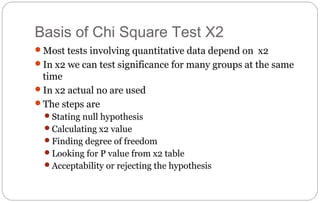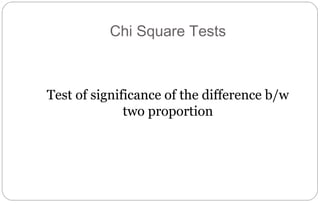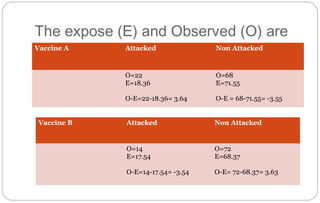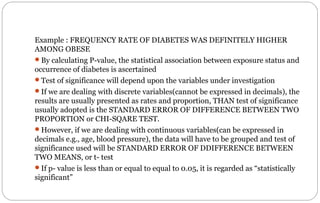Statistics tests and Probablity
- 1. By Dr Aijaz Ahmed Sohag MSc (Env:Sc),M.A.S(H.S.A.),MBA(Health Mgt),MPH , PhD Prep by: Abdul Wasay Baloch Amna Inayat Medical College Statistic Test
- 2. Test of Significance ‘t’ Test Summary points about ‘t’ Test Gosset in Dublin (1908) discovered it and called it ‘Student’ test later as ‘t’ Test To compare the means b/w groups t test is used Used if sample size is less than 30 If sample size is 30 or more than Z test is used Paired t ; when there is only one sample group is used and we take the means before and after interventions Unpaired ‘t’ test ; where two sample groups are used Formula of t or Z test is=X1-X2/SE, where X1=mean of group 1, and X2=mean of group 2
- 3. Indication of ‘t’ Test Quantitative data To compare two Means Random samples Normal distribution Sample size is less than 30 “S” unknown Continuous Data Parametric test
- 4. Types of ‘t’ Test One sample ‘t’ Test Two sample ‘t’ Test Paired Sample ‘t’ test
- 5. Level of Significance Alpha value: It gives probability of incorrectly rejecting the null hypothesis when it is actually true Traditional values are used as 0.05,0.01 + 0.001 When a test statistics falls in the area of critical region the result is referred to as SIGNIFICANT
- 6. Conventions for Interpreting P values P Value Interpretation P> 0.05 Result not significant P<0.05 Result significant P<0.01 Result highly significant P<0.001 Result is very highly significant
- 7. Testing Null Hypothesis In testing null hypothesis we have two decisions It is false – consequently rejected It is true – we fail to reject it If we do decisions as above – we do a correct decision If we commit a mistake to decide incorrectly – then we make/commit errors called alpha error and beta error
- 8. Errors of Hypothesis Testing Two types of Errors 1. Type 1 or α error : when we decide the null hypothesis is false, when it is actually true (no difference between two variables) Rejecting the null hypothesis when it is true Type 1 or alpha error(it is dangerous error) 1. Type 2 or β error: when we decide that null hypothesis is true when it is actually false Not rejecting the null hypothesis when it is actually false
- 9. inference Accept it Reject it Null Hypothesis Correct decision Type 1 error NH is false Type 2 Error Correct Decision In Medical studies Type 1 error is more serious as compared to Type 2 errors
- 10. Chi Square Test Advantages/Rationale a) Alternate method: to testify significance of difference between two proportions b)To determine whether there is some association between two variables c) It is applicable to qualitative data (where ‘t’ is not applicable)
- 11. Basis of Chi Square Test X2 Most tests involving quantitative data depend on x2 In x2 we can test significance for many groups at the same time In x2 actual no are used The steps are Stating null hypothesis Calculating x2 value Finding degree of freedom Looking for P value from x2 table Acceptability or rejecting the hypothesis
- 12. Chi Square Tests Test of significance of the difference b/w two proportion
- 13. An Example:Trial of 2 whooping cough vaccines Vaccine No of vaccinated No of cases Non Attacked Total A 2400 22 68 90 B 2300 14 72 86 Total 4700 36 140 176 •Apparently vaccine was B was superior to Vaccine A, to know whether the vaccine was really superior to vaccine A OR whether the diff was merely due to chance
- 14. Firstly we assume or test the hypothesis in following ways Considering the Null Hypothesis , that there was no differences b/w the effect of the two vaccines
- 15. Test the Null Hypothesis proportion of people attacked will be 36/176=0.204 Proportion of people not attacked will be 140/176=0.795 From these proportion we calculate the expected no. of people attacked or cases by vaccine A 90*0.024=18.36 Expected not attacked by vaccine A 90*0.795=71.55 Similarly expected no. of attacked by Vaccine B 86* 0.204=17.544 Expected no of non attacke by vaccine B 86*0.795=68.37
- 16. The expose (E) and Observed (O) are Vaccine A Attacked Non Attacked O=22 E=18.36 O-E=22-18.36= 3.64 O=68 E=71.55 O-E = 68-71.55= -3.55 Vaccine B Attacked Non Attacked O=14 E=17.54 O-E=14-17.54= -3.54 O=72 E=68.37 O-E= 72-68.37= 3.63
- 17. By applying the Chi Square test X2 = ∑ (O-E)/ E Combining O-E attacked case & non attacked case = 3.64^2/18.36 + 3.55^2/71.55 + 3.54^2 / 17.54 + 3.36^2/68.37 =0.72+0.17+0.71+0.19+1.7 B)Finding the degree of Freedom (d.f)- depends on no. of columns and rows in a table d.f=(c-1) (r-1) = (2-1) (2-1) =1 c) Referring Probability Table by referring Chi Square Probable table having d.f 1 against probability of 0.05 =3.84
- 18. Since the observed value in Chi Square table is much lower so the null hypothesis is true, hence Vaccine B is not superior to Vaccine A This test is valid only if the expected no.of each cell is not less than 2
- 19. Pakistan Demographic & Health Survey 06-07 About apprehension/non fulfillment of MDG on improved maternal health 96% women know about contraceptive knowledge, 22% using that One in four unmarried women has unmet need for family planning Most widely used method is Male Sterilization In Sindh women of age 15-49 is 27% Drop in total fertility rate from 5.4 children born to mother 90-91 to 4.1 children in 2006-07 1/3rd birth taken place within 24 months of previous birth which can be cited for increased Child Mortality More than 9 of every 100 children die before 5th birthday IMR in Sindh 8.1% while 7.8% in rest of country MMR in Sind ¾ deaths in every 100,000. 20% of female deaths due to Maternal causes
- 20. Half of birth by DAI, 39% by skilled doctor, nurse, midwife, LHV 47% children between 12 and 23 months receive all vaccines 02%of children under 5 02% pregnant women sleep under net The global population is growing by 80 miion people per year, 90% of it in poorer countries In past 50 years extraction from rivers, lakes and aqiofers has tripled to help meet population growth and demand for water intensive food such as rice cotton, dairy and meat products Agriculture accounts for 70% of the withdrawals, a figure that reaches more than 90% in some developing countries
- 21. PROBABILITY The probability of an event is denoted by P Probabilities are usually expressed as decimal fractions, not as percentages and must lie b/w zero (zero probability) and one (absolute probability) If the event is sure to occur, than p-value is 1(absolute probability), for e.g. all men sure to die. So probability is P = 100/100= 1(standard) 5 chances in 100=5/100 OR 1/20 OR 0.05. We can also say I chance in 20 is taken as cut off value
- 22. Example : FREQUENCY RATE OF DIABETES WAS DEFINITELY HIGHER AMONG OBESE By calculating P-value, the statistical association between exposure status and occurrence of diabetes is ascertained Test of significance will depend upon the variables under investigation If we are dealing with discrete variables(cannot be expressed in decimals), the results are usually presented as rates and proportion, THAN test of significance usually adopted is the STANDARD ERROR OF DIFFERENCE BETWEEN TWO PROPORTION or CHI-SQARE TEST. However, if we are dealing with continuous variables(can be expressed in decimals e.g., age, blood pressure), the data will have to be grouped and test of significance used will be STANDARD ERROR OF DDIFFERENCE BETWEEN TWO MEANS, or t- test If p- value is less than or equal to equal to 0.05, it is regarded as “statistically significant”
- 23. Smaller the p- value , the greater the statistical significance The smaller the P value, the greater the statistical significance or probability that the association is not due to chance alone. However, statistical association (P value) does not imply causation. P= 0.05 ( just significant at 5 percent level) P<0.05 (significant at 5 percent level) P>0.05 (not significant at 5 percent level)

